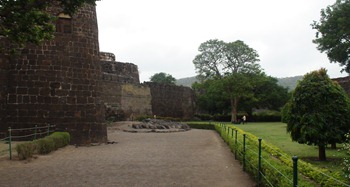About Me
As I mentioned in my previous post, during early Buddhism, there was no idol worship as the Buddha himself was against idol worship. With the rise of Mahayana Buddhism in North-Western India, the image of Buddha was introduced into the Buddhist art. This new culture started in Gandhara and Mathura, and defied the Hinayana school and gradually, the image of Buddha adorned all subsequent Buddhist sites.
There is a third sect in Buddhism called the Vajrayana. This sect is only found in Nepal and Tibet today. This sect introduced Tantric culture in the religion. A distinct feature of this sect is the the use of rituals as an alternative to the earlier abstract meditation. The lure towards the Hindu rituals to have control of some external forces probably created this sect. In fact, human psychology and hypnosis was an element of this practice which the Vajrayanas used to have control over other people. However, the tantric culture vanished in time but the sect remained.
How many of us know that Buddha is not a person? Buddha means “The Enlightened” and there are more than one in Buddhism. However, the most popular of the mortal Buddhas is Gautama., who is most widely represented in Indian Buddhist art. He appears in the sanctums of cave temples and also outside, depicted as either meditating or teaching. The Vajrayanas evolved the theory of the primordial god whom they called Adi Buddha or Vajradhara, popularly worshipped in Nepal and Tibet. He is heavily ornamented and and sits in the attitude of meditation and holds a thunder-bolt in the right hand and a bell in the left. You can find this image at the the monastery at Kushalnagaar in the Madikere district of Karnataka. The “Lalitha-Vistara”, a Mahayana text makes a mention of fifty-six Buddhas and seven Manushi Buddhas.
A Bodhisattva is the one who has become enlightened, acquired the Bodhi knowledge but who refuses to enter Nirvana since he desires to guide all mankind to the true path of the Buddha. The Bodhisattvas as namely Samatabhadra, Vajrapani, Ratnapani, Padmapani and Visvapani. There are many other Bodhisattvas in Mahayana Buddhism. The most popular of these are Avalokiteswara (Padmapani) and Manjusri. They are widely represented in India, Tibet, China and Japan.
It is believed that Maithreya is the Future Buddha. He will be born as a Manushi Buddha, 5000 years after the death of Gautama. During the period between the fourth Buddha i.e. Gautama and Maithreya, Avalokiteswara is to rule the world.
Now that we have discussed the iconography of Buddhism, we shall discuss about its rock cut architecture and the various constructions in the next post.
The 6th Century B.C was a time when men’s minds in several parts of the world were deeply stirred by the problem of religion and salvation. In India, this movement was active in the kingdom of Magadha. The ruling class, considered themselves better than their spiritual guides. Even the Brahmans were arrogant considering themselves superior to others.
This rebellion against the Brahmans caused many sects to be born, each advocating different opinions of the nature of God and and relation of God to Man. All of them died in time except two, Jainism and Buddhism. Both at one time pervaded almost every corner of India and enjoyed royal patronage. Buddhism unfortunately died out in India and is now confined to countries like Sri Lanka, Burma, Tibet, China and Japan. Judged by the posthumous effects on the world at large, The Buddha was the greatest man to be born ever in the Indian Sub Continent.
The story of Buddha and his life appears only in the later Buddhist scriptures but some of the references are totally unreliable. Certain details are very certain. He was the son of a Sakya chieftain and was named Siddhartha Gautama, became an ascetic at the age of 35 years, became a Buddha (The Enlightened) under a peepal tree, and died at the age of Eighty at Kushinagara. It is believed that he was seriously affected with dysentery after eating a meal of pork, served by a blacksmith. This could be true as it is said that Buddha advised his followers that eating meat is fine as long as the living beings have not been killed to serve the monks. His followers cremated him and his ashes were distributed among the rulers and elders of the local tribes.
Now the question comes, when and why sub-sects started in such a simple religion. At the second General Council at Vaisali, a hundred years after Gautama Buddha’s death, there was a big divide on monastic discipline and the Order split into Orthodox “Sthaviravadins” and “Mahasanghika”. These minor points of discipline were soon to follow by doctrinal differences of a very major importance, which in centuries to follow were the cause of a further more divide.
The Mahasanghika later was divided into Mahayana (The Great Vehicle) and Hinayana (The lesser one). The Mahayana was considered to be a path for Bodhisatvas to attain Buddhahood. In the early school of Buddhism, there was no idol worship. It was more of a symbol worship; the Bodhi Tree, an empty throne, foot marks which depicted Buddha, lotus flower, the wheel of Dharma etc. which depict various aspects of Siddhartha Gautama’s life. There was a time where the existence of Buddhism was in question. The Mahayana sect which were great in number had to pave way for Idol Worship. The idol worship was started by Acharya Nagarjuna, during the years 167 and 196 A.D when King Yajnasri was ruling the Satavahana Kingdom.
With an introduction to Buddhism, we talk more about the scriptures, sects and Buddhist art.
Planning for a 10 day trip was not easy. As always, the amount of reading was very deep and took almost a month. Choosing the places and route was again a challenge, which required a lot of travelling from one place to another. With a perfect itinerary, I started off. All accommodations were booked before.
Those 10 days were unforgettable. I travelled as if I was in air. Quick bites wherever I could find and liquids; Liquids kept me alive with all the marathon travelling, could be tea or water or soft drinks. Daulatabad was the most tiresome of treks, but very interesting understanding the history with a deep sense of psychological aspect of the construction of the Fort.
There were at times when I had to take a break for health reasons, because of which had to skip Sinhgad trek. Most memorable was roaming about Pune Streets, searching for a person whom I have never met and do not even know where he stays. It took 4 long hours of desperation and determination to meet the person, who enlightened me with little known facts which I shall write about in due course of time.
Lastly, a pleasant trip to Bhaja Caves with my wife (my fiancée then), a perfect ending to a straining journey.
It all started when I got down in Aurangabad at 2 AM in the night and started off with my journey. Before knowing about Aurangabad, I want to set the context with a little information on Buddhism and its Iconography in the forthcoming post.
It is somehow a surprising fact of Indian History that dynasties which were, at one time the greatest and path breakers have vanished in oblivion just like that. Even the places that had seen those days cease to be recognized. The Fort in Malkhed is one of such places from which the Rashtrakutas ruled.
The Rashtrakuta Empire ruled large parts of the Indian Subcontinent between the sixth and tenth Century A.D. However, their history can be traced till the 13th Century. The origin of this dynasty is a controversial topic, however, the Rashtrakutas of Manyakheta (our Malkhed) can be accurately traced by numerous contemporaneous inscriptions referring them. In fact many rulers, claimed to be Rashtrakutas at one point in time and ruled in parallel, parts of India. The crux of the empire extended from the Cauvery River in the South to the south of river Narmada on the North. At their peak, they were the only South Indian empire who conquered regions as far as Kannauj as well as extreme South. How can we forget the largest monolithic temple of the world, the Kailas Temple of Ellora? This was commissioned and built during the reign of Krishna I. Apart from multiple constructions in Ellora, Rashtrakutas contributed to Elephanta Caves and Cave Temples in Padatkal (Karnataka).
Malkhed became the capital city of Rashtrakutas during the rule of Amoghava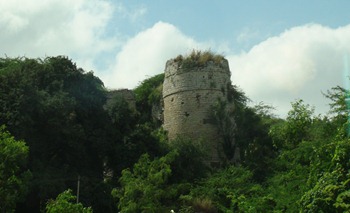 rsha I. This place was also the capital city of the Western Chalukyas till the end of 10th Century. Today, it is a barren land with traces of the brutally demolished glory. I came to know about this fort during my research before travelling and wanted to explore. I hired a vehicle to travel to Malkhed. 40 kilometers of bad roads, one hour of anticipation and a first visual of a huge bastion, I was extremely excited. Walls connect to the bastion and from outside, it looked like a brick structure with a coated layer. But on a close observation, it turned out to be crude sto
rsha I. This place was also the capital city of the Western Chalukyas till the end of 10th Century. Today, it is a barren land with traces of the brutally demolished glory. I came to know about this fort during my research before travelling and wanted to explore. I hired a vehicle to travel to Malkhed. 40 kilometers of bad roads, one hour of anticipation and a first visual of a huge bastion, I was extremely excited. Walls connect to the bastion and from outside, it looked like a brick structure with a coated layer. But on a close observation, it turned out to be crude sto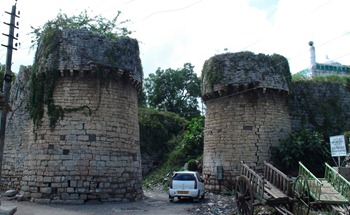 nes placed one upon the other.
nes placed one upon the other.
The entrance is massive with two large bastions on either side. There is a narrow design on the top of each bastion. Interestingly, this is also made of stone and fitted into the construction. Gaps in the stone structure are visible now and are in a very bad shape with no maintenance. 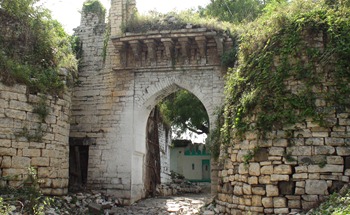 You can find a construction outside the entrance to the right which is recent but built off the stones inside the fort. As I moved inside I passed through one more gateway with smaller bastions on either side. This gateway has a small parapet with similar stone design as we had seen on the bastions of the main entrance. There is a small house inside this
You can find a construction outside the entrance to the right which is recent but built off the stones inside the fort. As I moved inside I passed through one more gateway with smaller bastions on either side. This gateway has a small parapet with similar stone design as we had seen on the bastions of the main entrance. There is a small house inside this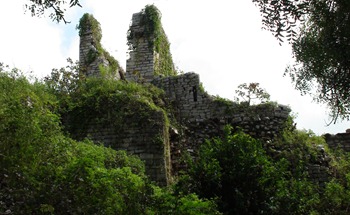 gateway being used by a Muslim family.
gateway being used by a Muslim family.
Once I passed through this house and turn right and walk through first visuals of the buildings appeared. I was astonished to see that they were all totally demolished with not even minimum maintenance. The entire walkway is filled with rubble and  stone. If you keenly observe, you can find walls on either side covered in bushes now. Such is the pathetic situation inside. You will find broken structures here and there. There is no way I could understand what kind of structures they were and what was their significance. I walked almost 300 meters further when I saw
stone. If you keenly observe, you can find walls on either side covered in bushes now. Such is the pathetic situation inside. You will find broken structures here and there. There is no way I could understand what kind of structures they were and what was their significance. I walked almost 300 meters further when I saw 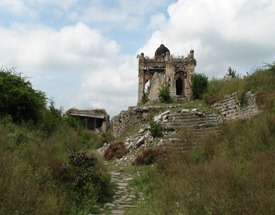 a small domed structure with an entrance at a distance. There is a flight of steps to reach this structure. The top of the entrance, made of brick and mortar is broken in the middle and can collapse any day. The entrance apparently was well decorated with minute carvings but none of it is clear.
a small domed structure with an entrance at a distance. There is a flight of steps to reach this structure. The top of the entrance, made of brick and mortar is broken in the middle and can collapse any day. The entrance apparently was well decorated with minute carvings but none of it is clear.
 Inside is a small domed mantapa with a broken parapet, decorated though. I carefully went inside. As expected, many parts of this structure are broken and lying here and there. There are three arches through which one can enter inside. The building is supported by 8 pillars within and three internal arches of the same style. The dome is decorated with an octagonal design. Finding that I do not have anything to see inside this mantapa, I proceed further to another small construction in this vicinity.
Inside is a small domed mantapa with a broken parapet, decorated though. I carefully went inside. As expected, many parts of this structure are broken and lying here and there. There are three arches through which one can enter inside. The building is supported by 8 pillars within and three internal arches of the same style. The dome is decorated with an octagonal design. Finding that I do not have anything to see inside this mantapa, I proceed further to another small construction in this vicinity.
Once I got near the other construction, I understood that it was a Jaina 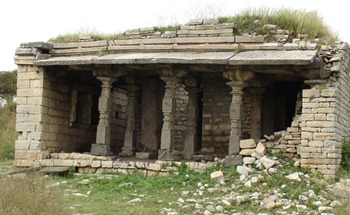 basadi. We always knew that Rashtrakutas as great patrons of the Jain religion. However, this is the only indication that I found inside the fort. This is a typical basadi with simple design. The posterior part of the basadi, the sanctum was reconstructed in recent times. By the looks it is difficult to identify the idol inside, but by the simplicity I am assuming it to be Adinatha or Shantinatha who were the foremost Tirthankaras. Also, the later Tirthankaras had typical identifiers which are not present in this one.
basadi. We always knew that Rashtrakutas as great patrons of the Jain religion. However, this is the only indication that I found inside the fort. This is a typical basadi with simple design. The posterior part of the basadi, the sanctum was reconstructed in recent times. By the looks it is difficult to identify the idol inside, but by the simplicity I am assuming it to be Adinatha or Shantinatha who were the foremost Tirthankaras. Also, the later Tirthankaras had typical identifiers which are not present in this one.
 There is a further road to the side of this basadi and I walked. It was a short but tiresome walk uphill. Further down, I came across a domed building again which I could not understand its importance. Considering the pitiable condition in which this place is, it is high time the authorities strive to do a face lift of the entire place and who knows, there might be unknowns waiting to be explored.
There is a further road to the side of this basadi and I walked. It was a short but tiresome walk uphill. Further down, I came across a domed building again which I could not understand its importance. Considering the pitiable condition in which this place is, it is high time the authorities strive to do a face lift of the entire place and who knows, there might be unknowns waiting to be explored.
When Amoghavarsha started ruling from Malkhed, he was already old and became a follower of the Digambara sect of Jainism. This could be a reason why the defenses of this fort look very weak. Even though the rulers were peace lovers, they frequently ventured into provoked battles and continued their legacy for the next 250 years without being defeated.
Manyakheta was plundered sometime after 1050 A.D and the dynasty was taken over the Chalukyas of Kalyani.
 Why were forts built? Was it for showing prominence? If it was only for a residence, is it necessary for the fort being such massive? Or was it just out of fear of death?
Why were forts built? Was it for showing prominence? If it was only for a residence, is it necessary for the fort being such massive? Or was it just out of fear of death?
All these thoughts came to my mind as I stood outside the Daulatabad Fort, waitin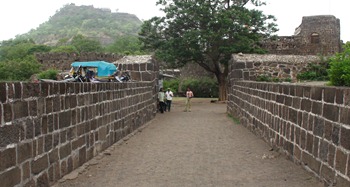 g for orders to march in. I waited years for this moment, and our army well prepared. In the midst of all, is my friend Tukaram. I asked him “Brother… You must be mad.. You know that you are blind… ” He simply answered “Anything for my motherland… ”. This shut me immediately. I took his left hand and said “Ok.. I am with you.. I heard a lot about the dangers inside.. Don’t leave me.. I will shout ‘kill’ and you can slash your sword.. We will win….”.
g for orders to march in. I waited years for this moment, and our army well prepared. In the midst of all, is my friend Tukaram. I asked him “Brother… You must be mad.. You know that you are blind… ” He simply answered “Anything for my motherland… ”. This shut me immediately. I took his left hand and said “Ok.. I am with you.. I heard a lot about the dangers inside.. Don’t leave me.. I will shout ‘kill’ and you can slash your sword.. We will win….”.
I must say that the kings have chosen a nice place for this fort. Hills on three sides and a river on the fourth. Tukaram asked “Hari, I heard Rashtrakutas are Jains. How come they are interested in war and killing?”. “I donno. We need to find out.” said I.
This call shook me and Tukaram.. “C’mon brother, it’s do or die now”. We started running towards the narrow passage to the main entrance. We have an obstruction brother, the enemy has placed two wooden planks at the narrow passage which hit our front runners. Fortunately, our elephants managed to break but it took their ene rgy”
rgy”
“Where is the entrance? I see only the fort wall… What a clever construction!.. The entrance is to the left invisible from the outside.. This is a deliberate attempt to confuse us”.
“Our army is making a clever move to place camels in front of elephants to push and break open the door. Iron Spikes are placed to hurt the elephants” I said. “There is artillery placed in the holes above the door.. We need to save ourselves…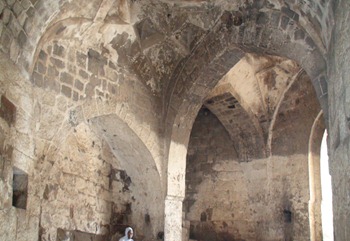 Also, there is a bastion inside the second wall from which arrows are shot. We are losing our people…” And we marched through the Amberkot, the outer wall of the fort.
Also, there is a bastion inside the second wall from which arrows are shot. We are losing our people…” And we marched through the Amberkot, the outer wall of the fort.
“It is not over.. There are wooden planks immediately after entering the door. There are square holes cut in the walls from which the planks are pushed. The first hit our elephants..And the second hit our horses..” “Brothers, put yourself”, I thought. But where is  the chance? There is a bastion right in front from which a volley of arrows have come and killed half of the soldiers passing.. “Why are our people screaming?” asked Tukaram in a trembling voice. “Another clever act. There is a square ventilator in the dome from which the enemies are pouring boiling oil” said I.
the chance? There is a bastion right in front from which a volley of arrows have come and killed half of the soldiers passing.. “Why are our people screaming?” asked Tukaram in a trembling voice. “Another clever act. There is a square ventilator in the dome from which the enemies are pouring boiling oil” said I.
“Brother! I am scared…”. This expression cleared my doubt..This fort was constructed in such a way that the attacker gets psychologically weakened even before the actual battle starts. We then entered the Mahakot, the 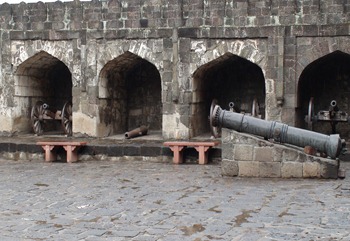 second line of defense. “Tukaram! This fort is simple un penetrable. There are four lines of enclosure walls with small and big bastions. Enemies are on all of them and throwing spears and arrows towards us. We need to move fast”. Saying this, I took his hand and started running. Out of nowhere, from the enclosures in the sides, came soldiers
second line of defense. “Tukaram! This fort is simple un penetrable. There are four lines of enclosure walls with small and big bastions. Enemies are on all of them and throwing spears and arrows towards us. We need to move fast”. Saying this, I took his hand and started running. Out of nowhere, from the enclosures in the sides, came soldiers and behind them cannons blasted boom..boom.. We narrowly escaped and ran forward.
and behind them cannons blasted boom..boom.. We narrowly escaped and ran forward.
“Looks like there is a side door.. Let’s go from there”, said I and started running behind others who opened the wooden door. “Tukaram! So many tricks. This side door opens into a deep wet moat.. Some of our people already fell into it and are perished. Poor folks.. eaten by alligators and crocodiles hungry and waiting. Our general says that he has information of 52 fake gates like this inside the fort, and 33 of them between the second and third gates. We need to be careful”. I understood that why so many of us have been called for this war. This fort need numbers to conquer. It is not easy.
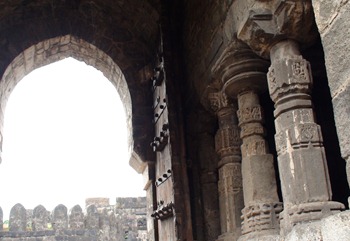 The space after the second door is empty. Have the protectors withdrawn? My doubts vanished when I saw a guard peeping through a small hole in the wall in front. “There are good sculptures of Mahishasura Mardhini and Parvathi on the pillars of a pavilion at this small arch. Looks likes these are remains of a Shiva Temple”, I explained. We had to walk slowly pushing each othe
The space after the second door is empty. Have the protectors withdrawn? My doubts vanished when I saw a guard peeping through a small hole in the wall in front. “There are good sculptures of Mahishasura Mardhini and Parvathi on the pillars of a pavilion at this small arch. Looks likes these are remains of a Shiva Temple”, I explained. We had to walk slowly pushing each othe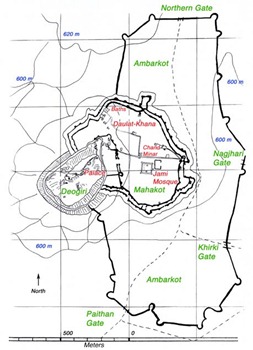 r as the way to the next arch is a bottleneck. “This is again a clever tactic to keep a control on the our pace”, I thought and have to admit that am amazed. There are other tricks as well. Usually, elephants are depicted to show way. Here elephants are carved in such a way to confuse an outsider so as to reach the wet moat, however, an insider can easily understand the way. This is again to psychologically bring down the morale.
r as the way to the next arch is a bottleneck. “This is again a clever tactic to keep a control on the our pace”, I thought and have to admit that am amazed. There are other tricks as well. Usually, elephants are depicted to show way. Here elephants are carved in such a way to confuse an outsider so as to reach the wet moat, however, an insider can easily understand the way. This is again to psychologically bring down the morale.
From this arch, the third and the fourth gates are visible. “Brother, this is going to be a long walk for us. Be prepared” said I. The distance from the second to the third seemed to be almost a mile. “There should have been a Shiva Temple  here once upon a time and I heard its name is Deepmalika”. The floor started getting uneven for us to walk briskly. “Tukaram! I see the farthest point of the fort from here. They can keep an eye on everything from there”, I said and moved forward. The Nandi Mantapa has been reconstructed as a mausoleum now. There are some stable type constructions. As expected, there
here once upon a time and I heard its name is Deepmalika”. The floor started getting uneven for us to walk briskly. “Tukaram! I see the farthest point of the fort from here. They can keep an eye on everything from there”, I said and moved forward. The Nandi Mantapa has been reconstructed as a mausoleum now. There are some stable type constructions. As expected, there  were soldiers inside and we brutally killed them. Me and Tukaram slashed a couple. “I can see a minaret from here. Seems it is the Chand Minar, the second highest in India after the Qutub Minar in Delhi”, I described to Tukaram. We passed beside the Chand Minar towards the next gate. I noticed one thing. Along with psychologically getting weakened, with this long stretch we are also physically gettin
were soldiers inside and we brutally killed them. Me and Tukaram slashed a couple. “I can see a minaret from here. Seems it is the Chand Minar, the second highest in India after the Qutub Minar in Delhi”, I described to Tukaram. We passed beside the Chand Minar towards the next gate. I noticed one thing. Along with psychologically getting weakened, with this long stretch we are also physically gettin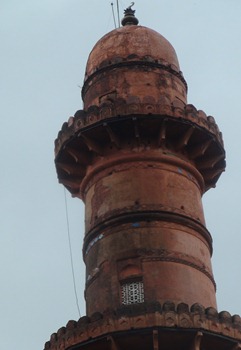 g exhausted. This, I believe is an important factor that was taken into consideration while building the fort. An interesting feature of the fort is that the walls are different in height alternatively. This is again to confuse the enemies about what is the route inside. Also, stone boulders are rolled from ahead somewhere. Our people have to skip those which will again disintegrate them a little hurting them physically and the confusion creates psychological impact.
g exhausted. This, I believe is an important factor that was taken into consideration while building the fort. An interesting feature of the fort is that the walls are different in height alternatively. This is again to confuse the enemies about what is the route inside. Also, stone boulders are rolled from ahead somewhere. Our people have to skip those which will again disintegrate them a little hurting them physically and the confusion creates psychological impact.
We finally see the third gate from the Minar and our arm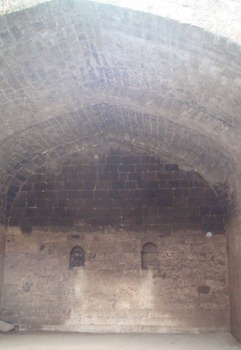 y is already frustrated with the tedious stretch. Even Tukaram was panting. Somehow, we reached the Kalkot. There are two gates now, to the left and right. “Tukaram! Our people started breaking the larger gate, which I am assuming leads further as the palace is also in the same direction. The right is a smaller one and could be a fake”. We bought down the huge gate. And what do we see? There is a wall behind. This is the fake gate. I see that the enemy has been successful to some extent taking the breath away from our folks. From this on, it was climbing stairs all along. Again there were enclosures from which soldiers were coming out in huge
y is already frustrated with the tedious stretch. Even Tukaram was panting. Somehow, we reached the Kalkot. There are two gates now, to the left and right. “Tukaram! Our people started breaking the larger gate, which I am assuming leads further as the palace is also in the same direction. The right is a smaller one and could be a fake”. We bought down the huge gate. And what do we see? There is a wall behind. This is the fake gate. I see that the enemy has been successful to some extent taking the breath away from our folks. From this on, it was climbing stairs all along. Again there were enclosures from which soldiers were coming out in huge 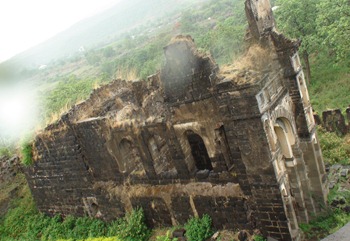 numbers. We passed the Chini Mahal where rulers like Shambhaji and Abu Hassan Tanashah were imprisoned.
numbers. We passed the Chini Mahal where rulers like Shambhaji and Abu Hassan Tanashah were imprisoned.
“Brother! Will the effort that we are putting in, we must win!” said Tukaram. I looked at him and smiled at his stubborn expression. We had to put all our strength to run to the place where is a bridge. We stopped. I saw enemies on the other side. Our people started  walking and suddenly screaming and dropped dead on the bridge. I realized that the bridge was made or iron and heated to extreme temperature such that no man can survive. We finally had to sadly step on dead bodies and reach the other side. We bought snakes with us which we put on the walls. I saw that the walls are so smooth that snakes cannot crawl.
walking and suddenly screaming and dropped dead on the bridge. I realized that the bridge was made or iron and heated to extreme temperature such that no man can survive. We finally had to sadly step on dead bodies and reach the other side. We bought snakes with us which we put on the walls. I saw that the walls are so smooth that snakes cannot crawl.
“Tukaram! I am going to be blind as you now”. I said this words when I saw  that a dark passage is the only way to the citadel. We took torches and moved inside. Our poor soldiers, if seen light went towards it and fell hundreds of feet in the moat. Also the passage has been constructed in such a way that I could not assume the way. Walls hit me to the left and right. Tukaram was trembling.
that a dark passage is the only way to the citadel. We took torches and moved inside. Our poor soldiers, if seen light went towards it and fell hundreds of feet in the moat. Also the passage has been constructed in such a way that I could not assume the way. Walls hit me to the left and right. Tukaram was trembling.
Finally, we were left with the treacherous climb t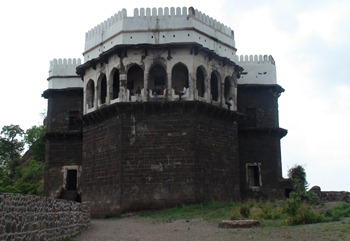 o the citadel. Hundreds of people from both sides perished. The King was almost defeated and waiting for a final fight. On the way, there is a Ganesha Temple which was constructed during the rule of Shivaji. I prayed for Tukaram and his determination. Finally, we reached the citadel and the King surrendered.
o the citadel. Hundreds of people from both sides perished. The King was almost defeated and waiting for a final fight. On the way, there is a Ganesha Temple which was constructed during the rule of Shivaji. I prayed for Tukaram and his determination. Finally, we reached the citadel and the King surrendered.
With the happiness of victory, we hugged and cried.
This post has been published by me as a part of IBL; the Battle of Blogs, sponsored by WriteupCafe.com. Join us at our official website and facebook page.
www.indianbloggersleague.com
www.facebook.com/IndianBloggersLeague
It has been a great experience writing about Bidar, which I think am the only person in recent times to have written extensively. Even though tracing down the Bahmani kingdom through its inception in Gulbarga to its final days in Bidar was tedious, I feel extremely happy and honored to introduce the last living descendants.
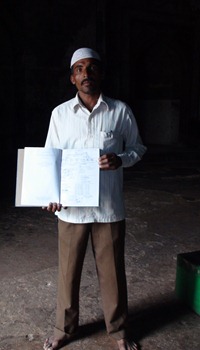 As you visit the Tomb of Ahmed Shah Wali Bahmani, you will find a simple looking man sitting guard inside. There is no such arrangement for the others. They are either locked or left open. I started talking to the person about the time and ages of the construction and I was taken aback. However, the pitiable conditions under which he is living, but he is still “His Royal Highness, Sultan Khaleel Shah Bahmani”, of the 12th generation.
As you visit the Tomb of Ahmed Shah Wali Bahmani, you will find a simple looking man sitting guard inside. There is no such arrangement for the others. They are either locked or left open. I started talking to the person about the time and ages of the construction and I was taken aback. However, the pitiable conditions under which he is living, but he is still “His Royal Highness, Sultan Khaleel Shah Bahmani”, of the 12th generation.
I was awestruck knowing this. I am face to face with a descendent of one of the most famous dynasties of the Deccan. I started talking to him more and he offered to take me to his house. Behind the tombs is a narrow muddy road which leads to a  small village. Looking at his home, I wondered what Ahmed Shah Wali could have thought seeing the member of his family staying at such a pitiable place. It is a small four room brick building with tiled roof.
small village. Looking at his home, I wondered what Ahmed Shah Wali could have thought seeing the member of his family staying at such a pitiable place. It is a small four room brick building with tiled roof.
“Everything has gone away with time” he sadly noted. The house he is living was given by the government after his family was evicted from the tomb premises. His family consists of his wife, four daughters and a son. In all these years he gathered information about his ancestors and can recognize them through paintings. He has also preserved a few coins minted by his ancestor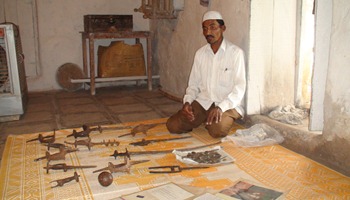 s. He has a good collection of armory like swords and daggers. He is not the only one of the dynasty. His brothers visit the place some times and they too are in the same economically backward condition, he said. He had refused to return the armory and coins to ASI fearing that his identity with the dynasty will be lost forever.
s. He has a good collection of armory like swords and daggers. He is not the only one of the dynasty. His brothers visit the place some times and they too are in the same economically backward condition, he said. He had refused to return the armory and coins to ASI fearing that his identity with the dynasty will be lost forever.
With the Bahmani dynasty introduced, I bid good bye to the land of Bidar and move on.
The name Takth Mahal is modern, for it is not mentioned in contemporary history, although the magnificence of the royal palace built by Ahmed-Shah-Wali at Bidar is extolled by Sayyid Ali Tabataba in his work entitled, Burhan-i-Maathir. The author mentions a palace and a forecourt but does not mention the name of the palace. It may be interesting to quote that this book gives certain features of the building, such as its arches and towers, and its blue tiles. The name Takth Mahal was apparently given by the literati of Bidar who had read accounts of Ferishta, who did not find a more appropriate edifice among the ruins of the Bahmani buildings which could be associated with the throne. The audience hall where the throne was actually placed did not meet the descriptions written by the above mentioned writers. The plan of the so-called Takth Mahal, however, agrees to them, and should not be confused with the Public Audience hall.
I cannot write much about this place owing to the fact that I am doubtful about the authenticity of the photographs I had taken. I am not sure if they belong to the Takth Mahal. However, I will end with a description of the throne. This throne was gifted to Sultan Tughlak Shah by Telinga (Andhra Kings) ambassadors as part of a peace treaty. Ferishta quotes eye witnesses that the throne was nine feet long and three feet broad. It was made of ebony covered with plates of pure gold, and set with precious stones of immense value. The throne had the flexibility of jewels being added and replaced. It became a custom that every prince had put their own mark of jewelry on the throne. During the reign of Sultan Muhammad Shah, it was valued at three and a half crores of rupees. This splendid throne was called the Firozah, owing, as Ferishta says, to it being partly enameled of a sky blue color was which in time was entirely concealed by the number of jewels.
This throne was was originally setup in the Durbar hall of Gulbarga was later moved to Bidar and put in the audience hall.
We have come to the end of our marvelous and memorable journey across the Bahmani Kingdom. I will end this series with an interesting account of a meeting… Watch out….
This is by far the most difficult post to write as it took one long month for me to gather information. The place is in ruins and it is very difficult to identify easily. However, referring to my pictures and the content that I studied, we could relate. This building was also called the Jali Mahal on account of some screens of trellis work which were visible in the early 19th century. Unfortunately, you cannot find trace of them today. The Archeological Department of Hyderabad conducted extensive excavations then and it has disclosed not only the plan of the building but also the architectural and decorative features. Most of the decorative stuff has been removed and stored in museums.
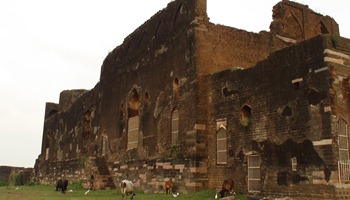 This building is situated to the west of the Zanana enclosure and is approached by a road which proceeds from the former. The outer wall of the Diwani-i-Am is preserved up to a considerable height on the southern side but it raises only to a few feet on the other three sides. It has two entrances to east and west but they do not face each other. The earlier excavations have exposed the original pavement of the eastern entrance, but the masonry of its outer and inner gateways, which must have comprised large blocks of carved stones, has all disappeared.
This building is situated to the west of the Zanana enclosure and is approached by a road which proceeds from the former. The outer wall of the Diwani-i-Am is preserved up to a considerable height on the southern side but it raises only to a few feet on the other three sides. It has two entrances to east and west but they do not face each other. The earlier excavations have exposed the original pavement of the eastern entrance, but the masonry of its outer and inner gateways, which must have comprised large blocks of carved stones, has all disappeared.
Passing through the entrance, we approach the court of the building which measures 166x133 feet in dimensions. The l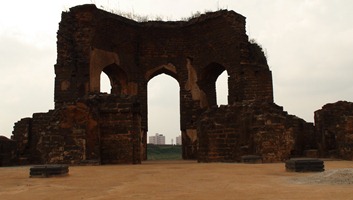 atter is divided into two parts. The principal hall of the building, which was probably used for public audiences is on the southern side and is approached by five steps from the pavement. The hall is divided into three apartments by rows of pillars, six in each row. The total length of the hall is 109 feet. These pillars of the hall were probably of wood, and they have all perished. The stone pedestals on which the wooden shafts rested are, however intact. The walls of the hall were originally decorated with panels of tile-work, some of them which have survived and currently being restored in museums. The colors of these tiles faded, for the tiles have reminded buried in debris for a number of years. It is said that two of these tiles were moved to a mosque in Bidar initially and later to a museum in Britain.
atter is divided into two parts. The principal hall of the building, which was probably used for public audiences is on the southern side and is approached by five steps from the pavement. The hall is divided into three apartments by rows of pillars, six in each row. The total length of the hall is 109 feet. These pillars of the hall were probably of wood, and they have all perished. The stone pedestals on which the wooden shafts rested are, however intact. The walls of the hall were originally decorated with panels of tile-work, some of them which have survived and currently being restored in museums. The colors of these tiles faded, for the tiles have reminded buried in debris for a number of years. It is said that two of these tiles were moved to a mosque in Bidar initially and later to a museum in Britain.
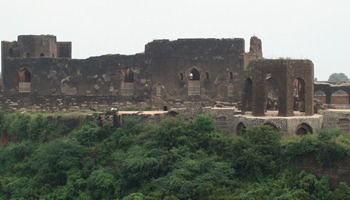 One of the panels had a calligraphic text in the form of Swastika containing the name of “Ali”, the son in law of Prophet Mohammed, repeated four times in the Kufic script. These tiles were probably made by Persian craftsmen, for artists and technicians of the latter country were much patronized by the Bahmanis. The ceiling of the hall may again have been of wood. In the hall was placed the Takth-i-Firoza, Turquoise throne. At the back of the hall remains of a room may be noticed, the middle one may have been for the King. The floor had mosaic design comprising geometrical patterns such as hexagons and stars. There are two more rooms behind the King’s chamber, probably belonging to the ministers. The remains of walls in the south indicate an upper storey which had an arched screen built along its sides.
One of the panels had a calligraphic text in the form of Swastika containing the name of “Ali”, the son in law of Prophet Mohammed, repeated four times in the Kufic script. These tiles were probably made by Persian craftsmen, for artists and technicians of the latter country were much patronized by the Bahmanis. The ceiling of the hall may again have been of wood. In the hall was placed the Takth-i-Firoza, Turquoise throne. At the back of the hall remains of a room may be noticed, the middle one may have been for the King. The floor had mosaic design comprising geometrical patterns such as hexagons and stars. There are two more rooms behind the King’s chamber, probably belonging to the ministers. The remains of walls in the south indicate an upper storey which had an arched screen built along its sides.
We now visit the Takth Mahal or the Royal Palace.
As I mentioned in the previous post, Gagan Mahal was a name commonly given. In fact, there are buildings with the same name in Anegondi (Hampi), Bijapur, Mudgal as well. Aptly named the Heavenly Palace, it was originally built by the Bahmanis and later altered by the Baridi rulers, notably the northern wing and the upper apartments of the southern wing. This monument is also out of reach to visitors and the information given is provided by eye witnesses when it was open to public.
 The palace has two courts, the outer apparently used by the male staff and the guards. Its entrance is behind the Solah Khamb mosque. On the southern side of the court is a series of rooms and halls build in rows one behind the other. Is is said that one the inside, there are arched entrances to all these rooms which were decorated with stucco and tile work.
The palace has two courts, the outer apparently used by the male staff and the guards. Its entrance is behind the Solah Khamb mosque. On the southern side of the court is a series of rooms and halls build in rows one behind the other. Is is said that one the inside, there are arched entrances to all these rooms which were decorated with stucco and tile work.
There were arcades on either side of the long inner court, the remains of  which may be seen today. The arcades to the north have been merged to the basement of the Tarkash Mahal which was built at a later date than the Gagan Mahal. The eastern and western parts have openings into the court which is said to have shown a nice proportion. In the ground floor, is an open space in the form of a pavement. There is a doorway through the pavement which leads to a double hall divided into six bays. At the back of this double hall is a narrow pavement with recessed windows opening on the moat which is all around the fort.
which may be seen today. The arcades to the north have been merged to the basement of the Tarkash Mahal which was built at a later date than the Gagan Mahal. The eastern and western parts have openings into the court which is said to have shown a nice proportion. In the ground floor, is an open space in the form of a pavement. There is a doorway through the pavement which leads to a double hall divided into six bays. At the back of this double hall is a narrow pavement with recessed windows opening on the moat which is all around the fort.
As a residential complex, the Gagan Mahal was aptly designed and decorated for a King with the queens harem. There is a terrace going up which commands a good view of the neighboring buildings. This terrace is also currently blocked.
The name Tarkash probably is given because the monument was built for the Turkish wife of the king, but a general conventionality is observed in giving names to the royal buildings. The names Tarkash Mahal and Gagan Mahal are mentioned in records of kingdoms like Bijapur and Golkonda as well. The rulers of the contemporary dynasties vied with one another in the glory of the architectural works and chose to have the same names for their palaces.
 The Tarkash Mahal at Bidar may have originally built by the Bahmanis but the upper parts are definitely built during the Baridi rule (the decorative emblem of the Baridi Kingdom is to be seen in the upper levels of the building). As on today, there is no access to the inner parts of the building owing to the pitiable conditions of the ruins but I shall talk about how it was earlier. The uppermost apartments are reached by a flight of steps which also lead to the roof of of the Solah Khamb Mosque. The roof of these apartments has fallen down but the walls are more or less intact which give a general idea of the plan of the building. In the middle is a hall with arched openings and was beautifully decorated with tiles and stucco work. The roof of the hall has fallen and originally there was another apartment above it, the remains of which in the shape
The Tarkash Mahal at Bidar may have originally built by the Bahmanis but the upper parts are definitely built during the Baridi rule (the decorative emblem of the Baridi Kingdom is to be seen in the upper levels of the building). As on today, there is no access to the inner parts of the building owing to the pitiable conditions of the ruins but I shall talk about how it was earlier. The uppermost apartments are reached by a flight of steps which also lead to the roof of of the Solah Khamb Mosque. The roof of these apartments has fallen down but the walls are more or less intact which give a general idea of the plan of the building. In the middle is a hall with arched openings and was beautifully decorated with tiles and stucco work. The roof of the hall has fallen and originally there was another apartment above it, the remains of which in the shape  of two arches can still be see as you see in the above picture. They too also decorated with stucco work.
of two arches can still be see as you see in the above picture. They too also decorated with stucco work.
There are smaller rooms on either side of the middle hall which was once decorated with encaustic tiles of which, we can still find some traces. The middle level rooms were earlier occupied by the court of the local officer. There are traces of an old parapet on the second level which suggests that the third level was built at a later time. On the ground level, the rooms were once used as storage for sundry articles and sometimes of ammunition. In fact, rockets were found in the early nineteenth century. This building has numerous halls like these.
 There is another building to the east of this which is also called the Tarkash Mahal, but it is in a very ruined condition. From the present remains, it can be made out that it had two storeys and that the upper level may have been occupied by the royal ladies. The architecture is clearly of the Baridi dynasty and so it can be assumed that this building is kind of an extension of the other Tarkash Mahal we had seen earlier.
There is another building to the east of this which is also called the Tarkash Mahal, but it is in a very ruined condition. From the present remains, it can be made out that it had two storeys and that the upper level may have been occupied by the royal ladies. The architecture is clearly of the Baridi dynasty and so it can be assumed that this building is kind of an extension of the other Tarkash Mahal we had seen earlier.
Both these names have been given in comparatively recent times, as this building is situated in the Zanana enclosure and as it has sixteen columns in the middle part of the prayer hall, which was screen ed off from the rest of the building when it fell into ruins. Its original name was Masjid-i-Jami, and the Friday Prayers and State functions where held here. It was built in the 1423 AD by the Sultan Mohammed Shah, the son of the first Bahmani ruler Ahmed Shah Wali. The year is recorded in an inscription that was found when the ASI was clearing the debris. The mosque can definitely be considered the earliest Muslim building in the city of Bidar.
ed off from the rest of the building when it fell into ruins. Its original name was Masjid-i-Jami, and the Friday Prayers and State functions where held here. It was built in the 1423 AD by the Sultan Mohammed Shah, the son of the first Bahmani ruler Ahmed Shah Wali. The year is recorded in an inscription that was found when the ASI was clearing the debris. The mosque can definitely be considered the earliest Muslim building in the city of Bidar.
Even though the length of the building is around 310 feet from north to south, it looks flat and  monotonous owing to its short height. There is a beautiful parapet above the arches but the effect is completely lost when seen from near. The pillars on the outside are square and the internal are round. The row of columns inside divide the prayer hall into 95 bays. Nine middle bays is occupied by a hall which is crowned by a majestic dome.
monotonous owing to its short height. There is a beautiful parapet above the arches but the effect is completely lost when seen from near. The pillars on the outside are square and the internal are round. The row of columns inside divide the prayer hall into 95 bays. Nine middle bays is occupied by a hall which is crowned by a majestic dome.
Access to the inside of the mosque is unavailable with iron doors been fitted at the arches. However, it is said that on the inside is an arrangement of a series of arched windows which are filled  with tracery. It, like the painted glass windows in cathedrals adds to the interior beauty of the prayer hall. To the western wall, is a pentagonal niche, entered by a hall of fine proportions. The niche points in the direction of the Kaba .The niche, technically called the mihrab, also marks the place of the Imam who conducts the prayers. The roof of the remaining part of the prayer hall comprises a series of smaller domes which are visible at the top but concealed from view by the parapet. The inside of the mosque is dark owing to the other two big buildings in the same vicinity which
with tracery. It, like the painted glass windows in cathedrals adds to the interior beauty of the prayer hall. To the western wall, is a pentagonal niche, entered by a hall of fine proportions. The niche points in the direction of the Kaba .The niche, technically called the mihrab, also marks the place of the Imam who conducts the prayers. The roof of the remaining part of the prayer hall comprises a series of smaller domes which are visible at the top but concealed from view by the parapet. The inside of the mosque is dark owing to the other two big buildings in the same vicinity which  were constructed later. We will talk about these in the further posts. It is said that there is a water reservoir on the roof of the mosque from which water flowed to the cisterns in the ground floor.
were constructed later. We will talk about these in the further posts. It is said that there is a water reservoir on the roof of the mosque from which water flowed to the cisterns in the ground floor.
The mosque has been repaired very well in recent years as earlier it was mostly rubble with cracks on the ceiling and floor. The building although one of the largest in India, suffers by comparison with its contemporary in Mandu or its predecessor at Gulbarga. The only pleasing feature is the middle hall crowned by the large dome.
The road near the north eastern corner of the Shahi Matbakh enters through an arch in the enclosure of the Royal Bathing place. The building was used as the Civil Court till early nineteenth century, but again with the efforts by Ghulam Yazdani was handed over to the ASI.  The round pillars that you see are added during the occupation by the Civil Court.
The round pillars that you see are added during the occupation by the Civil Court.
Behind the corridor is a double hall with 5 bays in each half. The divisions are arranged by arches, which again is a typical feature of the Bahmani constructions. The middle part of the building was apparently used as a waiting hall. The intermediate hall is the dressing place which consists of three apartments. The original roof fell down in late eighteenth century and was reconstructed. Beyond this was a single domed chamber. The dadoes of this chamber is said to have once adorned with tiles, but now only the stone margins indicating the outlines of the tiles are to be seen.
It is said that the plan of the innermost hall consists of a middle apartment which is broad enough to for accommodations of the bathing assistants, who filled the cold and hot tanks continuously. There are other retiring rooms which were also used for other social purposes. The ceiling of these rooms was vaulted, being divided into compartments. The exterior of the building is conspicuous, perhaps owing to the alterations done. On the roof was originally a parapet representing overlapping arches. As this design is generally of the Baridi style, it can be assumed that the Hammam was constructed either in the later Bahmani or the Baridi time. Portions of this parapet still exist in some places.
This building adjoins the Rangin Mahal and is a few steps away from the banyan tree we talked about in one of the pr evious posts. The building at one time may have been used for the royal kitchen, but it is too large for having built for that purpose, and from its plan it would appear to have been the residence of a prince or of some dignitary. There is an inscription to this effect in the inner entrance which says that a Bijapur general stayed here. There is another inscription which records the conquest of Ibrahim Adil Shah in 1619 AD. During the early 19th century, it was used as the District Jail but with the efforts of Ghulam Yazdani, it was handed over to the Archeological Survey of India.
evious posts. The building at one time may have been used for the royal kitchen, but it is too large for having built for that purpose, and from its plan it would appear to have been the residence of a prince or of some dignitary. There is an inscription to this effect in the inner entrance which says that a Bijapur general stayed here. There is another inscription which records the conquest of Ibrahim Adil Shah in 1619 AD. During the early 19th century, it was used as the District Jail but with the efforts of Ghulam Yazdani, it was handed over to the Archeological Survey of India. 
The building is entered by an arched gateway which leads to an open court. A modern colonnade with semi circular arches runs on three sides of this court. The south wing has an inner gateway and seven rooms with double apartments. On passing through the inner gateway a court is reached which has a spacious platform at the southern end. There is a small cistern in the middle of the platform, indicating the prese nce of fountains and water channels once. The main building of the palace faces north and comprises a series of rooms and chambers which now have been replaced with some modern constructions probably done during the time it was used as a jail.
nce of fountains and water channels once. The main building of the palace faces north and comprises a series of rooms and chambers which now have been replaced with some modern constructions probably done during the time it was used as a jail.
The domical halls are spacious and star shaped on the inside. There are squinches in the corners which make the plan of the hall look octagonal above the arches. It is probable that this palace was originally buil t by the Bahmani rulers. It is said that there are traces of some other rooms and in the upper stories but its out of reach now. Behind the western enclosure wall of the palace, is a large well which is approached by a ramp on the left side of the road. The masonry work of the well has been raised to a great height, so the water when drawn to that level might flow into the cistern and water fountains in the upper storey of the palace.
t by the Bahmani rulers. It is said that there are traces of some other rooms and in the upper stories but its out of reach now. Behind the western enclosure wall of the palace, is a large well which is approached by a ramp on the left side of the road. The masonry work of the well has been raised to a great height, so the water when drawn to that level might flow into the cistern and water fountains in the upper storey of the palace.
Continued from the previous post…
 The royal pavilion is also of small dimensions, the main room square and plain. It has windows on the east and west and a pentagonal projection towards the south. There are also projections in the corners which give a look of a star shaped m
The royal pavilion is also of small dimensions, the main room square and plain. It has windows on the east and west and a pentagonal projection towards the south. There are also projections in the corners which give a look of a star shaped m edieval Deccan temple. The beauty of the room lies in its rich decorations and mother-of-pearl work and tile mosaics. The former is fairly intact in the entrance arch, which is built of basalt of a very dark variety. The floral patterns and calligraphic texts have been depicted by inlaying mother-of-pearl of the finest quality. The effect is lovely and is further enhanced by the architect’s choice of the verses which he has inserted in the decorative scheme.
edieval Deccan temple. The beauty of the room lies in its rich decorations and mother-of-pearl work and tile mosaics. The former is fairly intact in the entrance arch, which is built of basalt of a very dark variety. The floral patterns and calligraphic texts have been depicted by inlaying mother-of-pearl of the finest quality. The effect is lovely and is further enhanced by the architect’s choice of the verses which he has inserted in the decorative scheme.
The pavilion once had a fountain in the middle, the basin on which is now lying in the outer court of the palace between the two flights of steps referred to in the previous post. Like the Mughal kings, the Baridis were also fond of fountains and it can be noticed in laying of waterworks in many of their buildings.
The R angin Mahal, however beautiful its wood carving and fascinating are its tiles and mother-of-peal work, suffers by the smallness of its dimensions and shows a lack of vision on the part of the builders. But the plan of the structure is so much altered at various periods, that it is difficult to visualize in its original form or to appraise correctly its beauty or defects.
angin Mahal, however beautiful its wood carving and fascinating are its tiles and mother-of-peal work, suffers by the smallness of its dimensions and shows a lack of vision on the part of the builders. But the plan of the structure is so much altered at various periods, that it is difficult to visualize in its original form or to appraise correctly its beauty or defects.
In the basement of the Rangin Mahal there is a series of rooms, which were apparently occupied by guards and the menial servants of the palace. The ceilings of these rooms are vaulted, being massively built with a view to supporting the weight of the royal apartments above.





